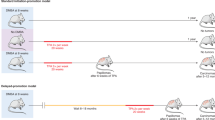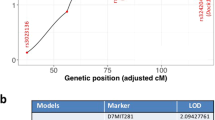Abstract
Using gene targeting techniques, mice that have been generated with two germ–line p53 null alleles (homozygotes) develop normally but are highly susceptible to early onset spontaneous tumours. Here, we show that mice with a single null p53 allele (heterozygotes) produced in the same way are also susceptible to spontaneous tumours, but with a delayed onset compared to homozygotes. The most frequent tumour type in homozygotes was malignant lymphoma; in heterozygotes, osteosarcomas and soft tissue sarcomas predominated. Heterozygous mice treated with a liver carcinogen, dimethylnitrosamine, showed a decreased survival time in comparison to treated wild type mice, suggesting that the p53–deficient mice may be useful for some in vivo carcinogenesis assays.
This is a preview of subscription content, access via your institution
Access options
Subscribe to this journal
Receive 12 print issues and online access
$209.00 per year
only $17.42 per issue
Buy this article
- Purchase on Springer Link
- Instant access to full article PDF
Prices may be subject to local taxes which are calculated during checkout
Similar content being viewed by others
References
Levine, A.J., Momand, J. & Finlay, C.A. The p53 tumour suppressor gene. Nature 351, 453–456 (1991).
Hollstein, M., Sidransky, D., Vogelstein, B. & Harris, C.C. p53 mutations in human cancers. Science 253, 49–53 (1991).
Caron de Fromentel, C. & Soussi, T. TP53 tumor suppressor gene: A model for investigating human mutagenesis. Genes, Chrom. Cancer 4, 1–15 (1992).
Chang, F., Syrjanen, S., Kurvinen, K. & Syrjanen, K. The p53 tumor suppressor gene as a common cellular target in human carcinogenesis. Am. j. Gastroenterol. 88, 174–186 (1993).
Nigro, J.M. et al. Mutations in the p53 gene occur in diverse human tumour types. Nature 342, 705–708 (1989).
Masuda, H., Miller, C., Koeffler, H.P., Battifora, H., Cline, M.J. Rearrangement of the p53 gene in human osteogenic sarcomas. Proc. natn. Acad. Sci. U.S.A. 84, 7716–7719 (1987).
Saylors, R.L. et al. Infrequent p53 gene mutations in medulloblastomas. Cancer Res. 51, 4721–4723 (1991).
Preudhomme, C. et al. Rare occurrence of p53 gene mutations in multiple myeloma. Br. J. Haematol. 81, 440 (1992).
Tsushita, K., Hotta, T., Ichikawa, A. & Saito, H. Mutation of p53 gene does not play a critical role in myelodysplastic syndrome and its transformation to acute leukaemia. Br. J. Haematol. 81, 456 (1992).
Moll, U., Riou, G. & Levine, A.J. Two distinct mechanisms alter p53 in breast cancer: mutation and nuclear exclusion. Proc. natn. Acad. Sci. U.S.A. 89, 7262–7266 (1992).
Malkin, D. et al. Germ line p53 mutations in a familial syndrome of breast cancer, sarcomas, and other neoplasms. Science 250, 1233–1238 (1990).
Srivastava, S., Zou, Z., Pirollo, K., Blattner, W. & Chang, E. Germ-line transmission of a mutated p53 gene in a cancerprone family with Li-Fraumeni syndrome. Nature 348, 747–749 (1990).
Toguchida, J. et al. Prevalence and spectrum of germline mutations of the p53 gene among patients with sarcoma. New Engl. J. Med. 326, 1301–1308 (1992).
Malkin, D. et al. Germline mutations of the p53 tumor-suppressor gene in children and young adults with second malignant neoplasms. New Engl. J. Med. 326, 1309–1315 (1992).
Ben-David, Y. & Bernstein, A. Friend virus-induced erythroleukemia and the multistage nature of cancer. Cell 66, 831–834 (1991).
Lavigueur, A. et al. High incidence of lung, bone, and lymphoid tumors in transgenic mice overexpressing mutant alleles of the p53 oncogene. Molec. cell. Biol. 9, 3982–3991 (1989).
Milner, J. & Medcalf, E.A. Cotranslation of activated mutant p53 with wild type drives the wild-type p53 protein into the mutant conformation. Cell 65, 765–774 (1991).
Kern, S. et al. Oncogenic forms of p53 inhibit p53-regulated gene expression. Science 256, 827–830 (1992).
Farmer, G. et al. Wild-type p53 activates transcription in vitro. Nature 358, 83–86 (1992).
Donehower, L.A. et al. Mice deficient for p53 are developmentally normal but susceptible to spontaneous tumours. Nature 356, 215–221 (1992).
Clapp, N.K., Craig, A.W. & Toya, R.E. Sr. Pulmonary and hepatic oncogenesis during treatment of male RF mice with dimethylnitrosamine. J. natn Cancer Inst. 41, 1213–1221 (1968).
Livingstone, L. et al. Altered cell cycle arrest and gene amplification potential accompany loss of wild-type p53. Cell 70, 923–935 (1992).
Yin, Y., Tainsky, M.A., Bischoff, F.Z., Strong, L.C. & Wahl, G.M. Wild-type p53 restores cell cycle control and inhibits gene amplification in cells with mutant p53 alleles. Cell 70, 937–948 (1992).
Kastan, M. et al. A mammalian cell cycle checkpoint pathway utilizing p53 and GADD45 is defective in ataxia-telangiectasia. Cell 71, 587–597 (1992).
Lowe, S.W., Schmitt, E.M., Smith, S.W., Osborne, B.A. & Jacks, T. p53 is required for radiation-induced apoptosis. Nature 362, 847–849 (1993).
Clarke, A.R. et al. Thymocyte apoptosis induced by p53-dependent and independent pathways. Nature 362, 849–852 (1993).
Triche, T.J. Unique features of childhood cancer. In Cancer Medicine, 3rd edn, (eds Holland, J.F. et al.) 2144–2152 (Lea & Febiger, Malvern, Philadelphia, 1993).
Miller, R.W. & Dalager, B. U.S. childhood deaths by cell type. J. Pediat. 85, 664 (1974).
Parkin, D.M. et al. Results from Contributing Centers—List of Tables. In International Incidence of Childhood Cancer, No. 87, 101–107 (Oxford University Press, 1988).
Hansen, M.F. & Cavenee, W.K. Genetics of cancer predisposition. Cancer Res. 47, 5518–5527 (1987).
Fournier, P. Biotransformation of dimethylnitrosamine. J. Toxicol. Clin. Exp. 10, 283–296 (1990).
Pritchard, D.J. & Butler, W.H. Apoptosis—The mechanism of cell death in dimethylnitrosamine-induced hepatotoxicity. J. Pathol. 158, 253–260 (1989).
Kemp, C., Donehower, L.A., Bradley, A. & Balmain, A. Reduction of p53 gene dosage does not increase initiation or promotion but enhances malignant progression of chemically induced skin tumors. Cell 74, 813–822 (1993).
Burns, P.A. et al. Loss of heterozygosity and mutational alterations of the p53 gene in skin tumours of interspecific hybrid mice. Oncogene 6, 2363–2369 (1991).
Author information
Authors and Affiliations
Rights and permissions
About this article
Cite this article
Harvey, M., McArthur, M., Montgomery, C. et al. Spontaneous and carcinogen–induced tumorigenesis in p53–deficient mice. Nat Genet 5, 225–229 (1993). https://doi.org/10.1038/ng1193-225
Received:
Accepted:
Issue Date:
DOI: https://doi.org/10.1038/ng1193-225
This article is cited by
-
Mutant p53 in cancer: from molecular mechanism to therapeutic modulation
Cell Death & Disease (2022)
-
Sensitivity to tumor development by TALEN-mediated Trp53 mutant genes in the susceptible FVB/N mice and the resistance C57BL/6 mice
Laboratory Animal Research (2021)
-
Single loss of a Trp53 allele triggers an increased oxidative, DNA damage and cytokine inflammatory responses through deregulation of IκBα expression
Cell Death & Disease (2021)
-
p53-mediated control of aspartate-asparagine homeostasis dictates LKB1 activity and modulates cell survival
Nature Communications (2020)
-
The path to metastatic mouse models of colorectal cancer
Oncogene (2018)



